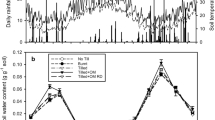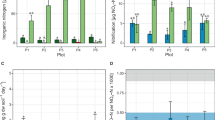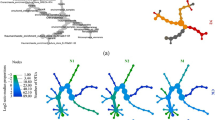Abstract
Characterization of spatial patterns of functional microbial communities could facilitate the understanding of the relationships between the ecology of microbial communities, the biogeochemical processes they perform and the corresponding ecosystem functions. Because of the important role the ammonia-oxidizing bacteria (AOB) and archaea (AOA) have in nitrogen cycling and nitrate leaching, we explored the spatial distribution of their activity, abundance and community composition across a 44-ha large farm divided into an organic and an integrated farming system. The spatial patterns were mapped by geostatistical modeling and correlations to soil properties and ecosystem functioning in terms of nitrate leaching were determined. All measured community components for both AOB and AOA exhibited spatial patterns at the hectare scale. The patchy patterns of community structures did not reflect the farming systems, but the AOB community was weakly related to differences in soil pH and moisture, whereas the AOA community to differences in soil pH and clay content. Soil properties related differently to the size of the communities, with soil organic carbon and total nitrogen correlating positively to AOB abundance, while clay content and pH showed a negative correlation to AOA abundance. Contrasting spatial patterns were observed for the abundance distributions of the two groups indicating that the AOB and AOA may occupy different niches in agro-ecosystems. In addition, the two communities correlated differently to community and ecosystem functions. Our results suggest that the AOA, not the AOB, were contributing to nitrate leaching at the site by providing substrate for the nitrite oxidizers.
Similar content being viewed by others
Log in or create a free account to read this content
Gain free access to this article, as well as selected content from this journal and more on nature.com
or
Accession codes
References
Altschul SF, Gish W, Miller W, Myers EW, Lipman DJ . (1990). Basic local alignment search tool. J Mol Biol 215: 403–410.
APHA (1985). Standard Methods for the Examination of Water and Wastewater, 16th edn. American Public Health Association: Washington, DC.
Bartossek R, Nicol GW, Lanzen A, Klenk HP, Schleper C . (2010). Homologues of nitrite reductases in ammonia-oxidizing archaea: diversity and genomic context. Env Microbiol 12: 1075–1088.
Belser LW, Mays EL . (1980). Specific inhibition of nitrate oxidation by chlorate and its use in assessing nitrification in soils and sediments. Appl Environ Microbiol 39: 505–510.
Bru D, Ramette A, Saby NPA, Dequiedt S, Ranjard L, Jolivet C et al. (2010). Determinants of the distribution of nitrogen-cycling microbial communities at the landscape-scale. ISME J; e-pub ahead of print 12 August 2010; doi:10.1038/ismej.2010.130.
Chen X, Zhu Y, Xia Y, Shen J, He JZ . (2008). Ammonia-oxidizing archaea: important players in paddy rhizosphere soil? Environ Microbiol 10: 1978–1987.
Conrad R . (1996). Soil microorganisms as controllers of atmospheric trace gases (H2, CO, CH4, OCS, N2O, and NO). Microbiol Rev 60: 609–640.
Dequiedt S, Thioulouse J, Jolivet C, Saby NPA, Lelievre M, Maron PA et al. (2009). Biogeographical patterns of soil bacterial communities. Environ Microbiol Rep 1: 251–255.
Di HJ, Cameron KC, Shen JP, Winefield CS, O’Callaghan M, Bowatte S et al. (2009). Nitrification driven by bacteria and not archaea in nitrogen-rich grassland soils. Nature Geosci 2: 621–624.
Di HJ, Cameron KC, Shen JP, Winefield CS, O’Callaghan M, Bowatte S et al. (2010). Ammonia-oxidizing bacteria and archaea grow under contrasting soil nitrogen conditions. FEMS Microbiol Ecol 72: 386–394.
Enquist BJ, Kerkhoff AJ, Stark SC, Swenson NG, McCarthy MC, Price CA . (2007). A general integrative model for scaling plant growth, carbon flux, and functional trait spectra. Nature 449: 218–222.
Enwall K, Throbäck IN, Stenberg M, Söderström M, Hallin S . (2010). Soil resources influence spatial patterns of denitrifying communities at scales compatible with land management. Appl Environ Microbiol 76: 2243–2250.
Erguder TH, Boon N, Wittebolle L, Marzorati M, Verstraete W . (2009). Environmental factors shaping the ecological niches of ammonia-oxidizing archaea. FEMS Microbiol Rev 33: 855–869.
Fierer N, Carney KM, Horner-Devine MC, Megonigal JP . (2009). The biogeography of ammonia-oxidizing bacterial communities in soil. Microb Ecol 58: 435–445.
Franklin RB, Mills AL . (2003). Multi-scale variation in spatial heterogeneity for microbial community structure in an eastern Virginia agricultural field. FEMS Microbiol Ecol 44: 335–346.
Garbeva P, Baggs EM, Prosser JI . (2007). Phylogeny of nitrite reductase (nirK) and nitric oxide reductase (norB) genes from Nitrosospira species isolated from soil. FEMS Microbiol Lett 266: 83–89.
Green JL, Bohannan BJM, Whitaker RJ . (2008). Microbial biogeography: from taxonomy to traits. Science 320: 1039–1043.
Groffman PM, Altabet MA, Böhlke JK, Butterbach-Bahl K, David MB, Firestone MK et al. (2006). Methods for measuring denitrification: diverse approaches to a difficult problem. Ecol Appl 16: 2091–2122.
Grundmann GL, Debouzie D . (2000). Geostatistical analysis of the distribution of NH4+ and NO2—oxidizing bacteria and serotypes at the millimeter scale along a soil transect. FEMS Microbiol Ecol 34: 57–62.
Hallin S, Jones CM, Schloter M, Philippot L . (2009). Relationship between N-cycling communities and ecosystem functioning in a 50-year-old fertilization experiment. ISME J 3: 597–605.
He JZ, Shen J, Zhang L, Zhu Y, Zheng Y, Xu M et al. (2007). Quantitative analyses of the abundance and composition of ammonia-oxidizing bacteria and ammonia-oxidizing archaea of a Chinese upland red soil under long-term fertilization practices. Environ Microbiol 9: 2364–2374.
Höfferle S, Nicol GW, Pal L, Hacin J, Prosser JI, Mandic-Mulec I . (2010). Ammonium supply rate influences archaeal and bacterial ammonia oxidizers in a wetland soil vertical profile. FEMS Microbiol Ecol 74: 302–315.
Hornek R, Pommerening-Röser A, Koops HP, Farnleitner AH, Kreuzinger N, Kirschner A et al. (2006). Primers containing universal bases reduce multiple amoA gene specific DGGE band patterns when analysing the diversity of beta-ammonia oxidizers in the environment. J Microbiol Meth 66: 147–155.
IPCC Core Writing Team, Pachauri RK, Reisinger A . (2007). Climate Change 2007 Synthesis Report: Contribution of Working Groups I, II and III to the Fourth Assessment Report of the Intergovernmental Panel on Climate Change. IPCC: Geneva.
Isaaks EH, Srivastava RM . (1989). An introduction to Applied Geostatistics. Oxford University Press: New York.
Jia ZJ, Conrad R . (2009). Bacteria rather than Archaea dominate microbial ammonia oxidation in an agricultural soil. Environ Microbiol 11: 1658–1671.
Jones CM, Stres B, Rosenquist M, Hallin S . (2008). Evolutionary history of denitrification as assessed by phylogenetic analysis of nitrite, nitric oxide and nitrous oxide respiratory enzymes. Molec Biol Evol 25: 1955–1966.
Könneke M, Bernhard AE, de la Torre JR, Walker CB, Waterbury JB, Stahl DA . (2005). Isolation of an autotrophic ammonia-oxidizing marine archaeon. Nature 437: 543–546.
Kowalchuk GA, Stephen JR . (2001). Ammonia-oxidizing bacteria: a model for molecular microbial ecology. Annu Rev Microbiol 55: 485–529.
Leininger S, Urich T, Schloter M, Schwark L, Qi J, Nicol GW et al. (2006). Archaea predominate among ammonia-oxidizing prokaryotes in soils. Nature 442: 806–809.
Mantel N . (1967). Detection of disease clustering and a generalized regression approach. Cancer Res 27: 209–220.
Martens-Habbena W, Berube PM, Urakawa H, de la Torre JR, Stahl DA . (2009). Ammonia oxidation kinetics determine niche separation of nitrifying Archaea and Bacteria. Nature 461: 976–979.
Mertens J, Broos K, Wakelin SA, Kowalchuck GA, Springael D, Smolders E . (2009). Bacteria, not archaea, restore nitrification in a zinc-contaminated soil. ISME J 3: 916–923.
Moran PAP . (1950). Notes on continous stochastic phenomena. Biometrika 37: 17–23.
Nicol GW, Leininger S, Schleper C, Prosser JI . (2008). The influence of soil pH on the diversity, abundance and transcriptional activity of ammonia oxidizing archaea and bacteria. Environ Microbiol 10: 2966–2978.
Offre P, Prosser JI, Nicol GW . (2009). Growth of ammonia-oxidizing archaea in soil microcosms is inhibited by acetylene. FEMS Microbiol Ecol 70: 99–108.
Pearson K . (1896). Mathematical contributions to the theory of evolution. III. Regression, heredity and panmixia. Phil Trans R Soc, Ser A 187: 253–318.
Philippot L, Bru D, Saby NPA, Cuhel J, Arrouays D, Simek M et al. (2009a). Spatial patterns of bacterial taxa in nature reflect ecological traits of deep branches of the 16S rRNA bacterial tree. Environ Microbiol 11: 3096–3104.
Philippot L, Cuhel J, Saby NPA, Cheneby D, Chronakova A, Bru D et al. (2009b). Mapping field-scale spatial patterns of size and activity of the denitrifier community. Environ Microbiol 11: 1518–1526.
Prosser JI, Nicol GW . (2008). Relative contributions of archaea and bacteria to aerobic ammonia oxidation in the environment. Environ Microbiol 10: 2931–2941.
Ritz K, McNicol W, Nunan N, Grayston S, Millard P, Atkinson D et al. (2004). Spatial structure in soil chemical and microbiological properties in an upland grassland. FEMS Microbiol Ecol 49: 191–205.
Röling WFM . (2007). Do microbial numbers count? Quantifying the regulation of biogeochemical fuxes by population size and cellular activity. FEMS Microbiol Ecol 62: 202–210.
Rotthauwe JH, Witzel KP, Liesack W . (1997). The ammonia monooxygenase structural gene amoA as a functional marker: Molecular fine-scale analysis of natural ammonia-oxidizing populations. Appl Environ Microbiol 63: 4704–4712.
Sahan E, Muyzer G . (2008). Diversity and spatio-temporal distribution of ammonia-oxidizing Archaea and Bacteria in sediments of the Westerschelde estuary. FEMS Microbiol Ecol 64: 175–186.
Savage VM, Webb CT, Norberg J . (2007). A general multi-trait-based framework for studying the effects of biodiversity on ecosystem functioning. J Theor Biol 247: 213–229.
Schauss K, Focks A, Leininger S, Kotzerke A, Heuer H, Thiele-Bruhn S et al. (2009). Dynamics and functional relevance of ammonia-oxidizing archaea in two agricultural soils. Environ Microbiol 11: 446–456.
Shen JP, Zhang LM, Zhu YG, Zhang JB, He JZ . (2008). Abundance and composition of ammonia-oxidizing bacteria and ammonia-oxidizing archaea communities of an alkaline sandy loam. Environ Microbiol 10: 1601–1611.
Spearman C . (1904). The proof and measurement of association between two things. Am J Psychol 15: 72–101.
Stamatakis A . (2006). RAxML-VI-HPC: maximum likelihood-based phylogenetic analyses with thousands of taxa and mixed models. Bioinformatics 22: 2688–2690.
Stamatakis A, Hoover P, Rougemont J . (2008). A fast bootstrapping algorithm for the RAxML web-servers. Syst Biol 57: 758–771.
Stenberg B, Johansson M, Pell M, Sjödahl-Svensson K, Stenström J, Torstensson L . (1998). Microbial biomass and activities in soil as affected by frozen and cold storage. Soil Biol Biochem 30: 393–402.
Thompson JD, Higgins DG, Gibson TJ . (1994). CLUSTAL W: improving the sensitivity of progressive multiple sequence alignment through sequence weighting, position-specific gap penalties and weight matrix choice. Nucleic Acids Res 22: 4673–4680.
Torstensson L . (1993). Guidelines. Soil Biological Variables In Environmental Hazard Assessment. Report No. 4262. Swedish Environmental Protection Agency: Solna.
Tourna M, Freitag TE, Nicol GW, Prosser JI . (2008). Growth, activity and temperature responses of ammonia-oxidizing archaea and bacteria in soil microcosms. Environ Microbiol 10: 1357–1364.
Treusch AH, Leininger S, Kletzin A, Schuster SC, Klenk HP, Schleper C . (2005). Novel genes for nitrite reductase and Amo-related proteins indicate a role of uncultivated mesophilic crenarchaeota in nitrogen cycling. Environ Microbiol 7: 1985–1995.
Venter JC, Remington K, Heidelberg JF, Halpern AL, Rusch D, Eisen JA et al. (2004). Environmental genome shotgun sequencing of the Sargasso Sea. Science 304: 66–74.
Wells GF, Park HD, Yeung CH, Eggleston B, Francis CA, Criddle CS . (2009). Ammonia-oxidizing communities in a highly aerated full-scale activated sludge bioreactor: betaproteobacterial dynamics and low relative abundance of Crenarchaea. Environ Microbiol 11: 2310–2328.
Wessén E, Nyberg K, Jansson JK, Hallin S . (2010). Responses of bacterial and archaeal ammonia oxidizers to soil organic and fertilizer amendments under long-term management. Appl Soil Ecol 45: 193–200.
Wetterlind J, Stenberg B, Söderström M, Stenberg M . (2005). New strategy for farm-soil mapping using near infrared spectroscopy to increase sample point density. In: Burling-Claridge GR et al. (eds). Proceedings of NIR in Action—Making a difference. IM Publications: Chichester, pp 299–303.
Zhang LM, Offre PR, He JZ, Verhamme DT, Nicol GW, Prosser JI . (2010). Autotrophic ammonia oxidation by soil thaumarchaea. Proc Natl Acad Sci USA 107: 17240–17245.
Zhou J, Kang S, Schadt CW, Garten CT . (2008). Spatial scaling of functional gene diversity across various microbial taxa. Proc Natl Acad Sci USA 105: 7768–7773.
Acknowledgements
We thank K Enwall for technical assistance. This work was supported by the Swedish Research Council for the Environment, Agricultural Sciences and Spatial Planning, Formas (contract 2009-741 and 2005-246) and the Swedish Farmers’ Foundation for Agricultural Research.
Author information
Authors and Affiliations
Corresponding author
Ethics declarations
Competing interests
The authors declare no conflict of interest.
Additional information
Supplementary Information accompanies the paper on The ISME Journal website
Supplementary information
Rights and permissions
About this article
Cite this article
Wessén, E., Söderström, M., Stenberg, M. et al. Spatial distribution of ammonia-oxidizing bacteria and archaea across a 44-hectare farm related to ecosystem functioning. ISME J 5, 1213–1225 (2011). https://doi.org/10.1038/ismej.2010.206
Received:
Revised:
Accepted:
Published:
Issue date:
DOI: https://doi.org/10.1038/ismej.2010.206
Keywords
This article is cited by
-
Inter-microbial competition for N and plant NO3− uptake rather than BNI determines soil net nitrification under intensively managed Brachiaria humidicola
Biology and Fertility of Soils (2022)
-
Effects of Land-Use Type and Flooding on the Soil Microbial Community and Functional Genes in Reservoir Riparian Zones
Microbial Ecology (2022)
-
The ammonia oxidizing bacterium Nitrosomonas eutropha blocks T helper 2 cell polarization via the anti-inflammatory cytokine IL-10
Scientific Reports (2021)
-
Diverse Thaumarchaeota Dominate Subsurface Ammonia-oxidizing Communities in Semi-arid Floodplains in the Western United States
Microbial Ecology (2020)
-
Distinct effect of nitrogen fertilisation and soil depth on nitrous oxide emissions and nitrifiers and denitrifiers abundance
Biology and Fertility of Soils (2018)



